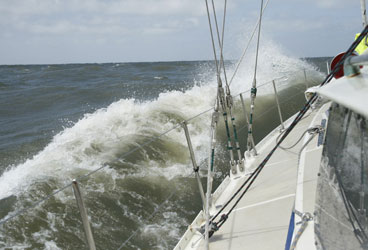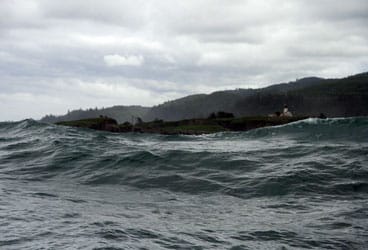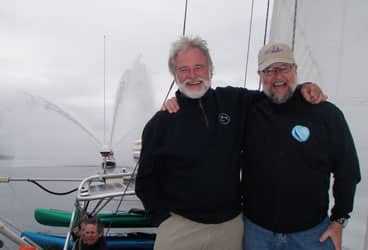
HW portland 368
The working definition of an “adventure” is a journey or an undertaking with an uncertain ending, and when we set off from Seattle, Washington, on May 31, 2009, we certainly had no idea what the outcome might be. But we did have a goal and a dream. To bring awareness to the plight of our oceans and to demonstrate that the continents of North America and South America could be considered one giant island surrounded by a common sea, we hoped to draw a figurative circle right “Around the Americas” (www.aroundtheamericas.org) in the wake of our 64-foot cutter, Ocean Watch.
In one sense, it seemed deceptively simple. In another, it didn’t quite seem reasonable or even possible. But the notion-Seattle to Seattle, via the Northwest Passage and Cape Horn-definitely had some audacious elements. If nothing else, we knew, we’d have ourselves an adventurous experience.
As it turns out, on a voyage like ours, the route isn’t at all circular: It’s much more like connecting a long series of dots. And so the line on our chart hopped from one dot-generally a cape or promontory, but sometimes an island-to the next. At the top of North America, we passed a glorified sand spit called Zenith Point, and off the bottom of South America. we enjoyed the single best day of the entire trip when we rounded Cape Horn. Along the way, on the eastern side of our big island, we negotiated Cape Cod, Cape May, Cape Hatteras, Cape Lookout, and Cape Canaveral, and once around the Horn, we knocked off many a waypoint familiar to U.S. West Coast cruisers, ones like Cabo San Lucas and Point Conception.
Finally, after putting San Francisco and the Golden Gate Bridge behind us and setting sail for the Pacific Northwest, there was only one cape left: Cape Flattery. We were almost home.

Herb McCormick| |Once abeam of Tatoosh Island and Cape Flattery, Ocean Watch exited the Pacific Ocean bound for Seattle.|
First, we enjoyed a remarkably benign day to cross the Columbia River bar en route to Portland, Oregon, our last major port stop before wrapping up matters. Mate Dave Logan has crossed the bar on numerous occasions but couldn’t remember a more passive afternoon. Of course, roughly 48 hours later, as we slipped past the bar and back out into the open Pacific Ocean, the breaking waves at the mouth of the river were roiled and confused, just like they’re supposed to be. Ocean Watch seemed fine, and we will be too, after we visit the dentist to have our fillings reset.
The scene at the Columbia bar was a woeful preview of coming attractions, as we spent one long, last night offshore slamming into stiff northerly winds and a contrary current. It was a movie we’d seen too many times before. But we didn’t have too far to go, and late the next afternoon, the lighthouse on Tatoosh Island and nearby Cape Flattery hove into view. It was the last dot to connect. After hugs and handshakes, as we steered Ocean Watch into the relatively protected waters of the Strait of Juan de Fuca, we put the grand Pacific behind us once and for all.

Herb McCormick| |With arcs of spray from a fire boat as the backdrop, skipper Mark Schrader and David Rockefeller, Jr., celebrate the successful trip “around the Americas.|
We stopped for a night in the small fishing village of Neah Bay before making our way to Port Townsend, our first stop after leaving Seattle on our outbound journey. After another evening there, we picked up a dozen of the scientists, teachers, friends, and supporters who’d crewed on specific legs with the core team-skipper Mark Schrader, Logan, photographer David Thoreson, and me-over the course of the long voyage. Among the sailors for the last leg to Seattle was David Rockefeller Jr., the founder of Sailors for the Sea, and Bryce Seidl, the C.E.O. of the Pacific Science Center, the primary backers of the expedition.
At a little after noon on June 17, on the 382nd day of the voyage, and with 27,524 nautical miles on the ship’s log, Ocean Watch sidled alongside the dock in Shilshole Marina where it had all started a little over a year before.
There were a million things to say, but suddenly we were uncharacteristically speechless. The circle was complete.








